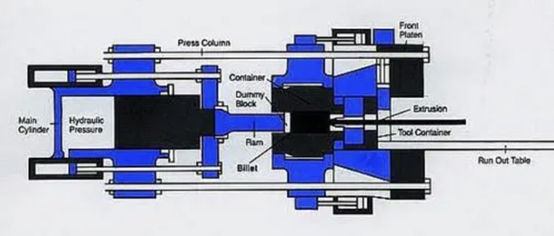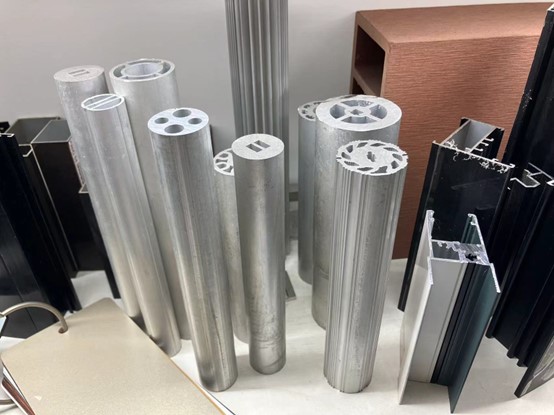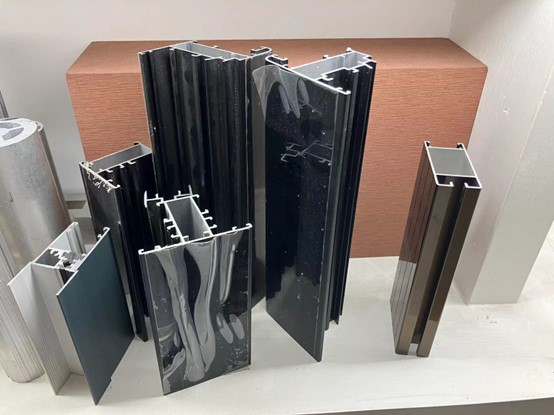TOP-Quality Aluminum Extrusion Services Supplier
Aluminum extrusion is a process in which heated aluminum billets (round aluminum bars) are pushed through a die to shape them into specific cross-sectional profiles. The extrusions service allows aluminum to be made into many shapes and sizes.
We have automated and semi-automated production lines at Hugh Aluminum, a leading extrusion supplier in China. Our extruders are from 800 to 2,500 tons and can produce intricate, big, and small aluminum profiles. Our products are ISO9001 certified, some have CE and EU export certification.

Hugh’s factory is automated, with the modern control system, some process like hardening, straightening and cutting can be semi-automatic or fully automatic. We have high daily output, meet the regional market demand with a short lead time, and can produce 50-200 tons per day (depending on the weight per meter of the product).
Also our factory can do deep processing and surface treatment for aluminum profiles. Our factory covers more than 25,000 square meters, we can provide services from product design to finished goods, this is not common in other extrusion factories.
Save your cost and time. Get the competitive aluminum.
Hugh’s Aluminum Extrusion Process
Aluminum extrusion is not just shaping metal, but it’s shaping raw material into building blocks for many uses. Every step from heating to post-processing has a reason, to deliver high-quality products. With precision and innovation, aluminum extrusions are the foundation of modern manufacturing.
Billet Preparation
Aluminum billets (cylindrical) are heated to 400-500°C (depending on alloy) to make them pliable for extrusion. Heating softens the aluminum, increases plasticity and reduces resistance during extrusion. If too cold, the extrusion pressure is too high and may cause material breakage or mold wear. If too hot, the mechanical properties may be compromised. Proper heating conditions optimize forming while retaining material properties like strength and toughness.
Extrusion
The softened billet is pushed into the extruder die, the die shapes the aluminum into the required profile. High pressure ensures the aluminum goes through the die and gets the desired shape and surface finish. The die determines the final shape of the profile and by controlling speed and pressure you can produce intricate and fine profiles with minimal waste.
Cooling and Straightening
Freshly extruded aluminum profiles come out hot and are cooled by air or water cooling. After cooling, there may be some bending, so mechanical straightening is required to get precision and flatness. Quick cooling locks in the material properties, and increases strength and hardness. Straightening improves product quality and accuracy.
Cutting
Cooled and straightened profiles are cut to customer length using saws or similar tools, smooth and neat cuts. Precision cutting aligns the profiles for further processing or installation and minimizes waste and errors during installation. Length control is efficient and versatile.
Post-Processing
Cut profiles can be further processed, anodized, painted or electroplated to increase corrosion resistance, aesthetics and mechanical properties. Surface treatments for outdoor or humid environments and decorative effects for architectural and furniture applications. Post-processing offers many finishes to improve the product’s overall performance.
Features and Benefits of Aluminum Extrusion
With its flexibility, strength, and eco-friendliness, it’s the backbone of many industries turning raw aluminum into components for many applications.
Flexibility
Aluminum extrusions can produce complex and detailed cross-sectional shapes, solid, hollow, and semi-hollow profiles. Aluminum is very pliable, especially when heated, and can be molded into almost any shape. This versatility makes extrusion perfect for industries like construction, automotive and electronics.
Lightweight and Strong
Aluminum profiles are very light but the extrusion process and post-processing make them stronger and harder than some heavy materials. Aluminum is one-third the density of steel but alloying and heat treatment makes it stronger. Good for applications that require weight reduction like aerospace and automotive.
Corrosion Resistance
Aluminum profiles naturally resist corrosion and anodizing makes it even better. When exposed to air, aluminum forms a natural oxide layer that prevents corrosion. Anodizing further enhances aluminum’s protective qualities making it suitable for outdoor and harsh environments.
Efficient and energy-saving
The aluminum extrusion process uses relatively low energy and aluminum is 100% recyclable without losing its properties. Using recycled aluminum billets in extrusion manufacturing reduces energy consumption. Aluminum is also light so it reduces transportation and installation costs.
High Precision
Extrusion can produce profiles with tight tolerances suitable for demanding mechanical and industrial applications. Modern extrusion machinery and die technology control profile dimensions precisely ensuring high dimensional stability and consistency meeting the requirements of automotive parts and building frames.
Applications of Aluminum Extrusion Products
- Building and Architectural Decoration: Window and door frames, decking, ceiling profiles, railings and roofing. Strong and the backbone of modern construction, they blend in seamlessly.
- Automotive: In cars T-slot structural profiles and decorative trim. The unsung heroes are under the bonnet and in the chassis, keeping it light and strong.
- Electronics: For gadgets and devices heat sinks and housings. Think of them as the cool heads in your electronics.
- Furniture: Furniture gets a modern look with aluminum extrusions in sliding rails and alloy components. They’re the players behind the scenes, where function meets style.
Every application shows the versatility and strength of aluminum extrusions, they’re more than just metal, they’re the backbone of today’s industries.



